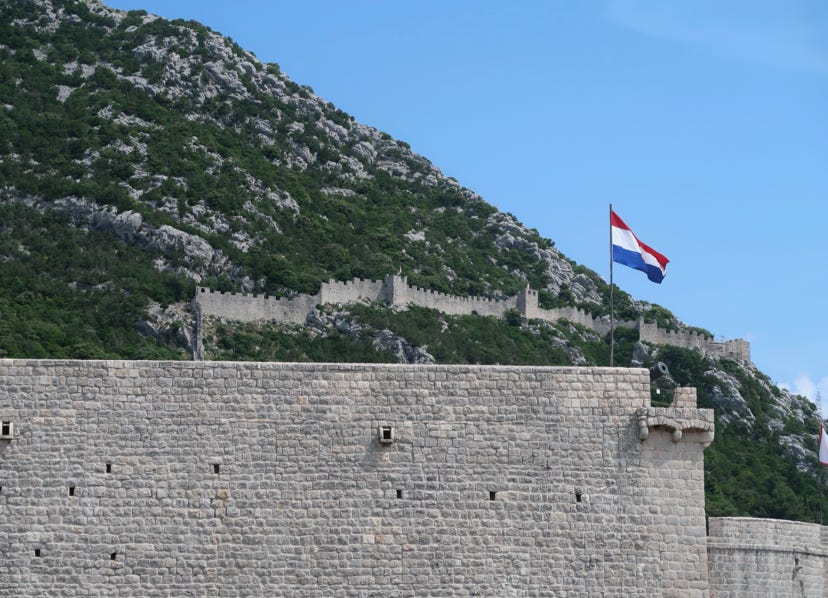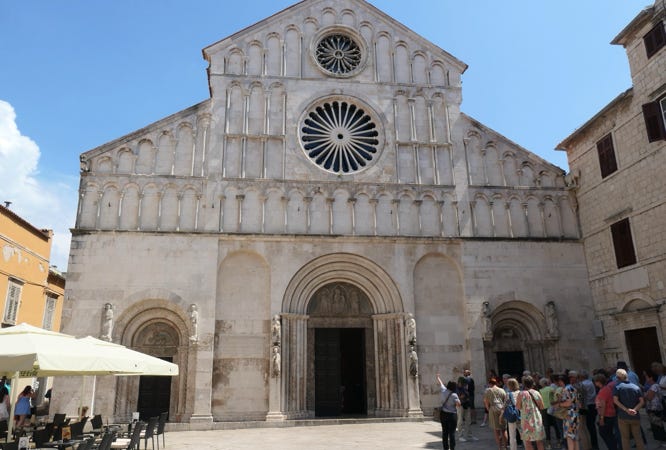
Dalmatian Coast
Korčula, Sibenik, Zadar, Pag and Nin
We departed Dubrovnik and drove north to the town of Ston, where we saw another set of impressive medieval walls. Then we drove on the scenic Pelješac Peninsula, which has vineyards and olive groves, plus impressive mountains down its spine. All along the Dalmatian Coast, we were impressed by the dramatic stone mountains which rose from the sea. We got to the ferry at Orebić, where we put the car in line for the ferry and had lunch.





Two photos of Ston and its impressive walls. Below, the town of Orbić from the ferry.

The ferry was a bit late departing for the port on the island of Korčula. After docking at Domince, we had a ten minute drive to the apartment we rented near the old town of Korcula. After checking in and doing some laundry, we explored the area and did some shopping. Before dinner in the old town, we relaxed on the terrace of our apartment with its panoramic view.

June 1, 2023
We decided to explore more of Korčula island and drove to the west through the towns of Pupnat, Čara, Smokvica and Brna. We continued on through the town of Blato, biggest on the Island, to the western most town of Vela Luka, with a nice harbor. The drive was very pretty, as the island offered views of nice vineyards, olive groves and impressive mountains.
We then drove back in the direction of Korčula town and to the beach past the town of Lumbarda and the lighthouse at Pt Raznjic, which has good views of the water and back towards the mainland. Photo below shows the pretty view from there.



After lunch, we explored the old part of Korčula town. We went through the town gate, with its Venetian lion and past the Rector’s Palace and St Michael’s church. Then we visited the attractive Cathedral of St Mark and its adjacent treasury museum. The cathedral boasts a Tintoretto paining from the era when Venice controlled Korčula and the museum shows a memento from Mother Teresa. We then climbed the church bell tower for wonderful views of Korčula town and surrounding areas. The last part of the climb was on a scary wire ladder. We elected to skip the touristy-sounding Marco Polo museum.


Korčula City Gate, Cathedral (detail shown at top of the page) and interior of a small
chapel. View from Cathedral tower shown below.

We next visited the City Museum, located in a Renaissance-era Gabrielis Palace. It has exhibits from the era before Christ through the early 20th century. It included a fossil from a rhinoceros from about 20 million years ago! We strolled to the top of the town and returned to our apartment along the old walls and spent the afternoon relaxing on our terrace before one last al fresco dinner along the walls of the old town.
June 2, 2023
We left the island of Korčula on the 15 minute ferry ride to Orebic. We drove halfway up the Pelješac Peninsula and took the spiffy new bridge from back to the mainland, instead of having to take a second ferry to get back to the mainland. Here’s a view back to Korčula town.

Once on the mainland, we drove through a verdant and fertile agricultural area with numerous roadside stands selling agricultural products, including honey, wine, olive oil, jams and, surprisingly, oranges. We drove north on the A1 highway, which we noted had many fewer service/rest stops than highways in other countries. Along the sunny drive, we saw very dark thunder clouds and many lightning strikes on the mountains just to the east.
We then drove to the town of Šibenik, which boasts a UNESCO World Heritage site, St James Cathedral. The outside was very impressive, but unfortunately the interior was undergoing extensive renovation. We then visited the museum associated with the Cathedral, which explained a lot about its founding and construction. We walked through the streets of the old town and visited one more church (St Francis), which was the opposite of the cathedral in its Romanesque simplicity.


Nice square and detail of the Cathedral, Šibenik.
As a reminder, here is the map of the routes we took.
From there we drove another hour north to the larger City of Zadar, and checked into our hotel, located on the old town island, just inside the city walls.
We took a short stroll around the old city, stopping at the very cool Sea Organ for a listen, and saw a couple of the old City gates/towers. Zadar struck us as more “lived in” than the other places we have been on this trip, although it still had a large number of visitors.
June 3, 2023
We left our hotel in Zadar and drove about an hour to Pag Island and the town of Pag. Pag is the origin of Croatia’s most famous sheep cheese. The landscape went from green and verdant to white stone, a remarkable contrast. In Pag town, we walked around the town and saw stone buildings and a church but were unable to find a cheese shop! Then we drove up to the top of the ridge above the town for a panoramic view. We drove back the way we came, past salt ponds and an old, ruined stone fortress.




Photos of Pag Cathedral, Pag Island, Pag town from above and
an old fortress.
We drove to another town, Nin, which was very important as a religious center in Medieval times. Nin also has a big salt factory and amazing old buildings. It had a better set of walls than Pag, including ruins of a first century Roman gate. Croats first arrived in the area in the eighth century. The cathedral and its bell tower are from the 12th century. The Church of the Holy Cross from the ninth century (!) was amazing. We had debated going to Pag or Nin, and were glad we made time to see both of them.

The walls of Nin, above, and below, the 9th Century

We returned to Zadar and took a walking tour of the old town. We saw the very fine archeology museum, which had collections from pre–history, Ancient Rome and medieval Croatia. After this, we saw the ruins of the Roman Forum nearby. Then we went to the ornately decorated Cathedral of St Anastasia, which also had a nice bell tower (it was too hot for us to climb it!). Then we went to the Church of Saint Donatus from the 9th century, with its amazing dome. We tried to visit two other churches, but found them closed on Saturday afternoon.


Zadar: Cathedral above left, dome of St. Donatus, left, a cool medieval carving from the museum, above right, and a Roman column near the forum, right.


We walked by some attractive city squares and came upon some surprising Roman and medieval ruins throughout the city. Lastly, we visited the amazing Museum of Ancient Glass. This was a unique and really amazing collection of well-preserved items, mostly from the Roman era. Here’s one sample.

After dinner, we visited the Salutation of the Sun art installation, with its flashing colored lights and a large, enthusiastic crowd, being entertained by a saxophone player. Here’s a short video.
We enjoyed our time and and around Zadar more than we expected and were surprised by the quality of the sights. Tomorrow, we head inland to the only area of Croatia that we are visiting that does not look like Italy.
